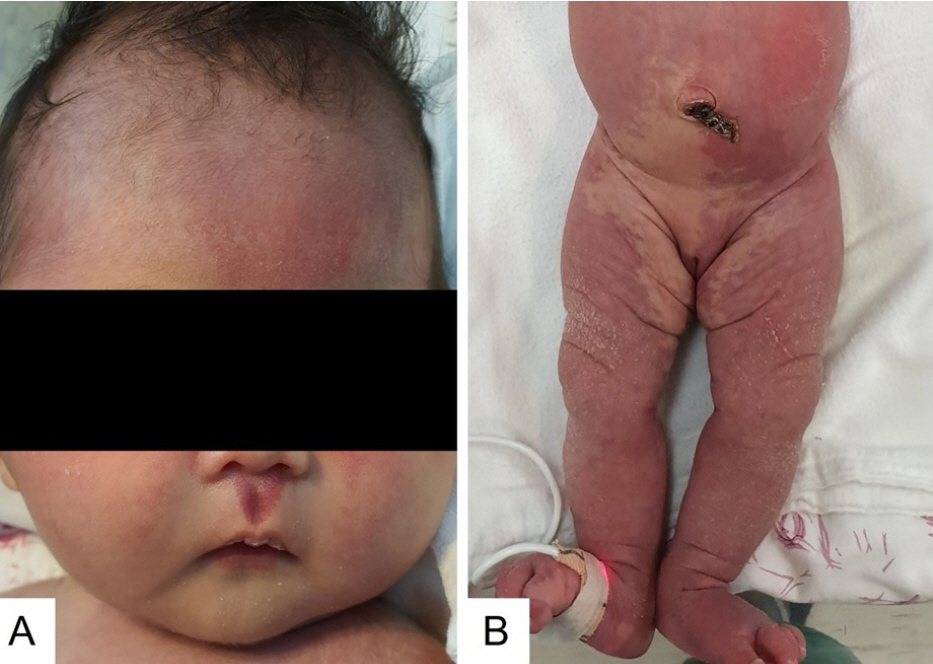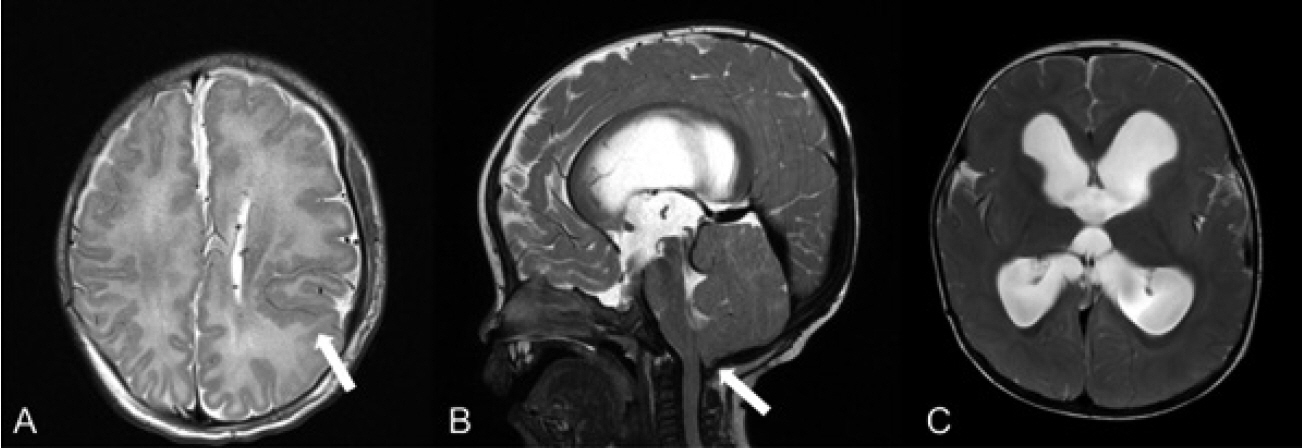Neonatal Med.
2023 May;30(2):55-59. 10.5385/nm.2023.30.2.55.
A Neonate Diagnosed with Megalencephaly-Capillary Malformation-Polymicrogyria Syndrome with PIK3CA Mutation
- Affiliations
-
- 1Department of Pediatrics, Gangneung Asan Hospital, University of Ulsan College of Medicine, Gangneung, Korea
- KMID: 2542548
- DOI: http://doi.org/10.5385/nm.2023.30.2.55
Abstract
- Megalencephaly-capillary malformation-polymicrogyria syndrome (MCAP) is a rare genetic disorder characterized by megalencephaly, polymicrogyria, body overgrowth, and cutaneous capillary malformations. It has been reported recently that MCAP is related to a somatic mosaic mutation in the phosphatidylinositol-4,5-bisphosphate 3-kinase catalytic subunit alpha (PIK3CA) gene. We report a case of hemimegalencephaly with polymicrogyria and cutaneous capillary malformations diagnosed by genetic evaluation of MCAP in the neonatal period. The PIK3CA mutation [c.1635G>T (p. Glu545Asp)] was determined by Sanger sequencing. The patient was treated with a ventriculoperitoneal shunt for progressive hydrocephalus. Because of the dynamic, progressive clinical manifestations and tumor-prone traits of MCAP, early diagnosis is important. Moreover, since the phosphoinositide 3-kinase (PI3K)-specific inhibitor, a targeted therapy for the PI3K/AKT/mTOR signaling pathway is emerging as a new therapy, early genetic diagnosis is becoming increasingly important.
Figure
Reference
-
1. Mirzaa GM, Conway RL, Gripp KW, Lerman-Sagie T, Siegel DH, deVries LS, et al. Megalencephaly-capillary malformation (MCAP) and megalencephaly-polydactyly-polymicrogyria-hydrocephalus (MPPH) syndromes: two closely related disorders of brain overgrowth and abnormal brain and body morphogenesis. Am J Med Genet A. 2012; 158A:269–91.
Article2. Wright DR, Frieden IJ, Orlow SJ, Shin HT, Chamlin S, Schaffer JV, et al. The misnomer “macrocephaly-cutis marmorata telangiectatica congenita syndrome”: report of 12 new cases and support for revising the name to macrocephaly-capillary malformations. Arch Dermatol. 2009; 145:287–93.3. Martinez-Glez V, Romanelli JVV, Mori MA, Gracia R, Segovia M, Gonzalez-Meneses A, et al. Macrocephaly-capillary malformation: analysis of 13 patients and review of the diagnostic criteria. Am J Med Genet A. 2010; 152A:3101–6.4. Mirzaa GM, Riviere JB, Dobyns WB. Megalencephaly syndromes and activating mutations in the PI3K-AKT pathway: MPPH and MCAP. Am J Med Genet C Semin Med Genet. 2013; 163C:122–30.
Article5. Akgumus G, Chang F, Li MM. Overgrowth syndromes caused by somatic variants in the phosphatidylinositol 3-kinase/AKT/mammalian target of rapamycin pathway. J Mol Diagn. 2017; 19:487–97.
Article6. Keppler-Noreuil KM, Parker VE, Darling TN, Martinez-Agosto JA. Somatic overgrowth disorders of the PI3K/AKT/mTOR pathway & therapeutic strategies. Am J Med Genet C Semin Med Genet. 2016; 172:402–21.
Article7. Gripp KW, Baker L, Kandula V, Conard K, Scavina M, Napoli JA, et al. Nephroblastomatosis or Wilms tumor in a fourth patient with a somatic PIK3CA mutation. Am J Med Genet A. 2016; 170:2559–69.8. Venot Q, Blanc T, Rabia SH, Berteloot L, Ladraa S, Duong JP, et al. Targeted therapy in patients with PIK3CA-related overgrowth syndrome. Nature. 2018; 558:540–6.
Article9. Choi YC, Yum MS, Kim MJ, Lee YJ, Ko TS. Megalencephalycapillary malformation-polymicrogyria syndrome: the first case report in Korea. Korean J Pediatr. 2016; 59(Suppl 1):S152–6.
Article10. Park SM, Kim GW, Cho HH, Kim WJ, Mun JH, Song M, et al. Megalencephaly-capillary malformation syndrome. Korean J Dermatol. 2015; 53:546–51.11. Kim YM, Lee Y, Choi Y, Choi IH, Heo SH, Choi JM, et al. Clinical and genetic analyses of patients with lateralized overgrowth. BMC Med Genomics. 2022; 15:206.
Article12. Park HJ, Shin CH, Yoo WJ, Cho TJ, Kim MJ, Seong MW, et al. Detailed analysis of phenotypes and genotypes in megalencephaly-capillary malformation-polymicrogyria syndrome caused by somatic mosaicism of PIK3CA mutations. Orphanet J Rare Dis. 2020; 15:205.
Article13. Clayton-Smith J, Kerr B, Brunner H, Tranebjaerg L, Magee A, Hennekam RC, et al. Macrocephaly with cutis marmorata, haemangioma and syndactyly: a distinctive overgrowth syndrome. Clin Dysmorphol. 1997; 6:291–302.
Article14. Fortin O, Ashour M, Lacroix C, Sabapathy CA, Myers KA. Megalencephaly-capillary malformation-polymicrogyria with cerebral venous thrombosis. Can J Neurol Sci. 2020; 47:828–9.
Article15. Di Rocco F, Licci ML, Garde A, Mottolese C, Thauvin-Robinet C, Chevarin M, et al. Surgical management of Chiari malformation type 1 associated to MCAP syndrome and study of cerebellar and adjacent tissues for PIK3CA mosaicism. Eur J Med Genet. 2023; 66:104678.
Article16. Madsen RR, Vanhaesebroeck B, Semple RK. Cancer-associated PIK3CA mutations in overgrowth disorders. Trends Mol Med. 2018; 24:856–70.
Article17. Morin G, Degrugillier-Chopinet C, Vincent M, Fraissenon A, Aubert H, Chapelle C, et al. Treatment of two infants with PIK3CA-related overgrowth spectrum by alpelisib. J Exp Med. 2022; 219:e20212148.
Article
- Full Text Links
- Actions
-
Cited
- CITED
-
- Close
- Share
- Similar articles
-
- Megalencephaly-capillary malformation-polymicrogyria syndrome: the first case report in Korea
- Commentary on “Megalencephaly-capillary malformation-polymicrogyria syndrome: the first case report in Koreaâ€
- Megalencephaly-capillary Malformation Syndrome
- Smith-Kingsmore syndrome: The first report of a Korean patient with the MTOR germline mutation c.5395G>A p.(Glu1799Lys)
- A case of unilateral megalencephaly



